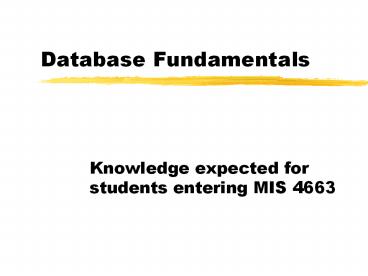Database%20Fundamentals - PowerPoint PPT Presentation
Title:
Database%20Fundamentals
Description:
Database Fundamentals. Knowledge expected for students entering MIS 4663 ... An inter ... (BPM) Overview of. technology. architecture. E-R Diagrams (Entity ... – PowerPoint PPT presentation
Number of Views:34
Avg rating:3.0/5.0
Title: Database%20Fundamentals
1
Database Fundamentals
- Knowledge expected for students entering MIS 4663
2
Information Systems
3
TheSDLC
4
System An inter-related set of components, with
identifiable boundaries, working together for
some purpose.
5
Analysis
The process of identifying problems, opportunities
, requirements, constraints, and resources.
6
Design
The business of finding a way to meet the
functional requirements within the specified
constraints using the available technology.
7
Zachman Framework
Network or
Data Processes Technology
Lists of entities important to the business
Overview of technology architecture.
Lists of functions that the business
performs. (BPM)
Ballpark (Business Scope)
Enterprise communication diagram
Functional Hierarchy Diagram
Owner (Business Model)
E-R Diagrams (Entity Level)
E-R Diagrams (Attribute Level)
Distribution Diagram
Designer (IS Model)
Dataflow Diagrams
Database Design
Configuration Design
Process Specifications
Builder (Technology Model)
Schema and Sub-schema Definition
Detailed (Technology Specification)
Configuration Definition
Program Code
Working Application
Installed Infrastructure
Functional System
Physical Tables
8
Systems Development Life Cycle (SDLC)
Often called Waterfall Model Iterative
Process Control cost and time Budgets Proje
ct timelines and deadlines Works best with well
understood systems Employed on most large
development projects.
9
Systems Development Life Cycle (SDLC)
Problem Identification Planning
Understanding Current Situation
Selection of Best Approach
Business or Logical Requirements
Physical Design, Coding and Testing
Implementation
Maintenance
Hoffer, George Valacich
10
SDLC Criticisms
- Process Overhead
- Significant time and resource costs.
- Project Milestones
- Discourages iterative changes to higher level
models in - light of lower level developments.
- Not suited for poorly understood systems.
- Difficult to apply if system requirements are
not well - defined.
- Testing Methodology
- Bottom up testing may result in components that
work - separately but not together.
11
Database Fundamentals
- E/R Modeling
- Decompose a narrative description into a data
model that includes entities, relationships and
constraints - Use the E/R paradigm to develop enterprise (high
level) models, conceptual models, and relational
models as needed - Identify attributes and domain constraints for
them
12
Database Fundamentals
- Normalization
- Decompose a database into 3NF relations from an
attribute set. - Use normalization to recognize design errors in
existing databases
13
Database Fundamentals
- SQL
- Create data access retrievals (SELECT statements)
from existing databases. - Single table queries with conditions (SELECT
WHERE ) - Joins (SELECT WHERE KEY1 KEY2)
- Subset and group conditions (SELECT WHERE
GROUP BY HAVING )
14
Database Fundamentals
- Access programming
- Create a multi table database including 1m and
mn relationships - Create a program that includes forms, reports,
macros and navigation using controls
15
Database Fundamentals
- For general use
- DBMS operation
- Understand how database management systems
provide concurrency control, - Understand backup and recovery using commits and
rollbacks and checkpoints - Understand integrity and how it is managed
- Explain other DBMS functions































